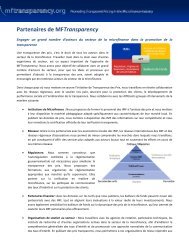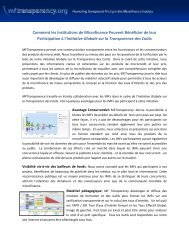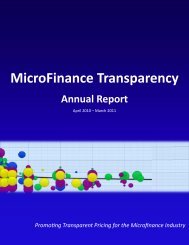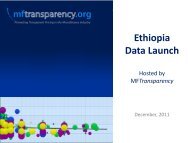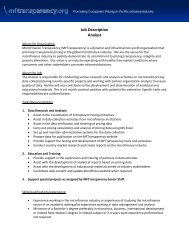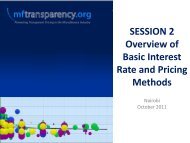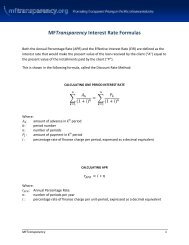SESSION 1 How Microfinance Differs from Traditional Finance
SESSION 1 How Microfinance Differs from Traditional Finance
SESSION 1 How Microfinance Differs from Traditional Finance
Create successful ePaper yourself
Turn your PDF publications into a flip-book with our unique Google optimized e-Paper software.
<strong>Microfinance</strong> is at a significanttransition point• 2005 to present• <strong>Microfinance</strong> has evolved into an established, fastgrowingbusinessBut has someactivity gottentoo commercial?
Profits in <strong>Microfinance</strong>Return on Equity, Latin America
Compartamos ROE vs Mexican Banks
…the media continues to be skeptical
Maintaining a Healthy Industry1. Consumer Protection through:1. Self-regulation2. Certification3. Codes of Ethics2. Transparency of Financial Information1. Financial Statements2. Ratings Agencies3. Transparent Pricing3. Dialogue with governments about appropriateregulation
Client Protection Principles1. Appropriate product design and delivery2. Prevention of over-indebtedness3. Transparency4. Responsible pricing5. Fair and respectful treatment of clients6. Privacy of client data7. Mechanisms for complaint resolution
<strong>How</strong> did microfinance end up withnon-transparent pricing?
Which loan would you pick?Zero InterestLoanInterest andFeesAnd SavingsInterestOnlyLoan amount: $1,000 $1,000 $1,000 $1,000Loan term: 10 weeks 10 weeks 10 weeks 10 weeksInterest Rate: 0% 15% “flat” 12% “flat” 40% declUpfront fee: 5% 2% 1% 0%Security deposit: 0% 0% 20% 0%TCC $50 $50 $33 $42APR 49% 47% 49% 40%TransparencyIndex0 32 25 100
The Downward Spiral• <strong>How</strong> did prices get so confusing and nontransparent?• It is a combination of:◦ Lack of transparent pricing regulation◦ Initial motivation of a small minority tomask the true price• The result is a downward spiral drawing innearly all MFIs
The Downward Spiral• All MFIs have transparentprices• MFI 1:◦ Interest: 2.5% decl.• MFI 2:◦ Interest: 3.0% decl.
The Downward Spiral• All MFIs have transparentprices• Some MFIs shift to flatinterest• MFI 1:◦ Interest: 2.5% decl.• MFI 2:◦ Interest: 2.0% flat
The Downward Spiral• All MFIs have transparentprices• Some MFIs shift to flatinterest• All MFIs shift to nontransparentpricing• MFI 1:◦ Interest: 1.75% flat• MFI 2:◦ Interest: 2.0% flat
The Downward Spiral• All MFIs have transparentprices• Some MFIs shift to flatinterest• All MFIs shift to nontransparentpricing.. Andit continues• MFI 1:◦ Interest: 1.75% flat• MFI 2:◦ Interest: 1.6% flat, 2%upfront fee
The Downward Spiral• All MFIs have transparentprices• Some MFIs shift to flatinterest• All MFIs shift to nontransparentpricing• Consumers struggle tochoose…. Which wouldYOU choose?• MFI 1:◦ Interest: 1.75% flat• MFI 2:◦ Interest: 1.6% flat, 2%upfront fee
The Downward Spiral• All MFIs have transparentprices• Some MFIs shift to flatinterest• All MFIs shift to nontransparentpricing• Consumers struggle tochoose… Because theprices are far <strong>from</strong> clear• MFI 1:◦ Interest: 1.75% flat◦ APR: 37%• MFI 2:◦ Interest: 1.6% flat, 2%upfront fee◦ APR: 57%
The Downward Spiral• All MFIs have transparentprices• Some MFIs shift to flatinterest• All MFIs shift to nontransparentpricing• Consumers struggle tochoose• Profits are correlated toprice when loans areidentical• MFI 1:◦ Interest: 1.75% flat◦ APR: 37%◦ ROE: 10%• MFI 2:◦ Interest: 1.6% flat, 2%upfront fee◦ APR: 57%◦ ROE: 40%
The Downward Spiral• Prices are far <strong>from</strong> clear, and thus:◦ Consumers over-consume◦ Market competition is hindered◦ Strong temptation <strong>from</strong> high profits◦ The poor are harmed◦ Public image is tarnished◦ Governments urged to intervene• Transparency, and particularly pricing transparency,is a key element to correct this serious problem inthe microfinance industry
Two common questions withoutsimple answers:1) What is the “market price” ofmicrocredit?2) What is a “responsible price” formicrocredit?
AveragePrice
Too High!Responsible Pricing RangeTooLow!
Is there a curve in othercountries?
The interesting question:Are institutions “off-of-thecurve”pricing responsibly?
Why is there a price curve formicro-loans?
Are there cost curves in real data?
Cost Components that Affect PricingComponentFinancial Costs 10%Loan Loss 2%Operating Costs 20%Profit 3%Total Price 35%
In the Philippines, we find a curve not only forprices, but also for Operating Costs.
Common industry benchmark of 15-20%OpCost Ratio is appropriate for larger loans
But smaller loans generate an Op CostRatio well in excess of 20%
Notice that in all three countries there is aremarkably consistent spread between OCRand Yield
Understanding the cost curve formicro-loans
Efficiency: Operating Cost RatioThe formula for the ratio:Annual Operational Cost------------------------------Average Loan PortfoliioWe will analyze at the level of a single loan• Cost to process and disburse a loan (once per loan)• Monitoring cost (monthly cost)• We annualize these cost
Pricing for Different ProductsComponent$100 Loan $1000 LoanFinancial Costs 10% 10%Loan Loss 2% 2%Operating Costs 50% 15%Profit 3% 3%Total Price 65% 30%
Promoting Transparent Pricingin the <strong>Microfinance</strong> Industry
CONCLUSIONS




